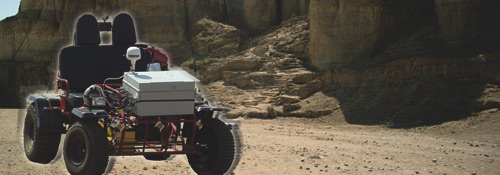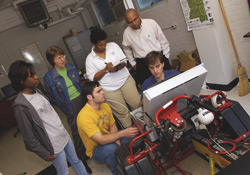

With the help of the U.S. Army, a UM doctoral student is working to reduce American casualties by developing a robot vehicle able to travel through a battlefield and solve problems on its own.
Although the Department of Defense aims to convert one-third of all military ground transport into unmanned ground vehicles by 2015, a viable autonomous robotic prototype has yet to be developed.
That’s where Doris Turnage comes in. While pursuing a doctorate in computer science, Turnage, a 19-year veteran Army researcher, is also working to turn an everyday all-terrain vehicle into a technologically advanced, decision-making autonomous robotic vehicle.
“The ultimate goal is to create a vehicle that can go into areas where humans cannot or should not go,” Turnage says. “An autonomous vehicle is different from just unmanned. This isn’t remote control. It’s far more complicated than that.”
The complexities of designing an autonomous unmanned ground vehicle (or UGV, in military-speak) enjoyed a public demonstration back in March when the Pentagon’s Defense Advanced Research Projects Agency sponsored a 210-mile UGV race across California’s Mojave Desert.
DARPA dangled a $1 million prize, with the purse to go to the first robotic vehicle to complete the rugged course in 10 hours. From a field of 100 applicants, only 14 teams from universities, private companies and one high school qualified for the race, which turned out to be a tad anticlimactic.
After all the hoopla, the best UGV in the DARPA challenge race made it a paltry 7.4 miles before veering off course and getting stuck. Several others didn’t make it out of the starting gate. DARPA will sponsor a second race in October 2005, this time with a $2 million prize.
Turnage doubts her UGV will be ready by then. At this point, she says, she’s aiming for a short-term goal of getting the vehicle to choose to move in a square and “come back to where it’s supposed to.” Turnage can already control the UGV with her laptop, making it a sort of oversized remote control car. But that’s the easy part.
“An autonomous vehicle is capable of making decisions on its own based on the software,” Turnage says. “It should be able to do this the same or better than a human controller. We know it can be done, but it’s very complicated. The software’s only as good as the person writing it.”
Turnage has a bachelor’s degree in mathematics from the University of Southern Mississippi and a master’s in computer science from Mississippi State. She chose UM for her doctorate specifically to work with Pamela Lawhead, a veteran computer science professor with experience working with robots.
 Engineering faculty and students work to mount 360-degree cameras onto the UGV. Working on the project are Bridget Knight (standing left), a senior in mechanical engineering; computer science professor Pamela Lawhead; graduate student Doris Turnage; mechanical engineering professor J.P. Sharma; mechanical engineering senior Jarrad Zaiser (seated left); and Chris Cummins from the Army Corps of Engineers.
Engineering faculty and students work to mount 360-degree cameras onto the UGV. Working on the project are Bridget Knight (standing left), a senior in mechanical engineering; computer science professor Pamela Lawhead; graduate student Doris Turnage; mechanical engineering professor J.P. Sharma; mechanical engineering senior Jarrad Zaiser (seated left); and Chris Cummins from the Army Corps of Engineers.
Lawhead and two classes of graduate students had already built Skip, an autonomous robot vehicle made from a Fisher-Price Silverado electric truck, a small child’s riding toy. Using a grant from alumnus Skip Sauls, the classes set out to build an autonomous robot vehicle in miniature and on the cheap; they spent only $6,000 on the entire project.
Skip features additional motors for steering, sonar, vision and GPS units. The students consulted electrical engineering faculty for advice on how to wire the breadboards, minicomputers that do the thinking to move the machine.
“As far as we got was to make Skip follow a black line,” Lawhead says, which doesn’t sound like much. But Skip laid the groundwork for more advanced robotics research.
“The subsumptive architecture is there to write the control aspects for the big machine,” Lawhead says. “We just have to scale it up.”
An all-terrain, autonomous UGV poses bigger problems than a toy truck. Instead of using sensors to move, Turnage must build entire systems for the all-terrain vehicle. It must be able to travel off road, navigating crossings and not faltering if the terrain becomes hilly.
“That’s the problem of navigating open terrain,” Lawhead says. “The robot must be able to make the right responses.”
Although Turnage has never worked in robotics before, her background uniquely suits her to take on this project. The Brandon native has worked for the Army for 19 years, spending several years at White Sands Missile Range near El Paso, Texas, as a systems administrator for a very large military computer system.
In 1990, she returned to her home state to work for the Army Corps of Engineers in Vicksburg. There, she works for the Engineer Research and Development Center in the mobility systems branch, testing Army vehicles for field readiness.
“From the math background—working with different computer systems to testing for the ERDC—everything has come full circle,” Turnage says. “I hope that this will be my specialty for life.”
To that end, she’s spent the past year studying the basics of robotics in classes and in independent studies guided by Lawhead. The rest she’ll learn on the job with her UGV.
Because Turnage remains a full-time employee of the Army Corps of Engineers, the UGV project is completely funded by the Army. The Army donated the all-terrain vehicle that is being converted into a UGV, delivering it to the School of Engineering at the end of the spring 2004 semester. Then Turnage rolled up her sleeves and got to work.
“This is a long-term project; not something that can be solved in six months,” Turnage says. “Hopefully, I’ll be done by spring 2006.”
For their senior project, two mechanical engineering students, Bridget Knight of Jackson and Jarrad Zaiser of The Woodlands, Texas, created a mounting system that allows the UGV’s cameras to turn 360 degrees. Eventually, this will allow the robot to pick the best direction to travel.
Lawhead says having access to a robotic vehicle on the scale and complexity of the UGV has been “an incredible opportunity for everybody—not just our students.”
The main stumbling block to Turnage’s progress so far isn’t high-tech at all—it’s dead batteries. She added several motors to the ATV to control steering and movement, but a faulty motor has been draining power from the batteries. Once that problem is fixed, the UGV project will be off and running again.
In August, Turnage and the UGV traveled back to Vicksburg so that she can continue to work for the Army Corps of Engineers while she works on the robot. When the project is completed, however, the UGV will belong to the university.
Turnage says that her ultimate goal for the UGV project does not involve winning a DARPA Challenge race across the Mojave Desert, should one be held in 2006.
“As a government employee, I’m ineligible for the money anyway,” Turnage says.
“In the long term, I want to see my vehicle fielded with the Army. “I want it to be used on the battlefield to save soldiers’ lives.”